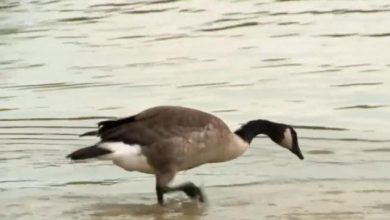KosAbility: H5N1 ‘avian’ flu found in cats

Avian flu doesn’t just kill wild birds and poultry: cats, dogs, pet birds and their caregivers can all be infected, as can at least 19 other animal species. Although documented cases in cats and dogs are rare, now is the best time to know the signs and adopt avoidance measures. Human cases have mainly occurred through contact with infected poultry (one came from a cow), and the risk of transmission to humans from infected cats and dogs is low. To pose a greater risk to humans, the virus would need to mutate and become more capable of infecting mammals. The recent discovery of U.S. dairy cattle infected with avian flu in eight states, however, represents a new concern even though cattle generally recover after a month or two.
For 150 years, the highly pathogenic Avian influenza has spread across the world and now, as the risk to non-avian animals increases, “avian” is not an appropriate name and it should be referred to by its subtype – H5N1 influenza – until an official name is enforced by the World Organization for Animal Health.
When dairy cattle infected with H5N1 were discovered in the United States a month ago, researchers began surveying farms and discovered seven American barn cats also infected.
The potential for H5N1 to infect domestic cats is not new: 29 cats in Poland were documented carrying H5N1 as of June 2023 and all died. The surveillance report for this incident indicated that the genetic analyzes of the viruses found in these cats were very similar, suggesting that the cats were all infected from the same source. After testing food samples from associated households, the pathogen was detected in a sample of poultry meat.
On American farms, affected cats were noticed due to respiratory and neurological signs consistent with H5N1:
- Conjunctivitis,
- Periocular swelling,
- Respiratory signs,
- Flatness,
- depression, and
- Other neurological signs (including cerclage and blindness).
The seven cats are dead and “It is unclear whether the cats became infected by consuming sick birds, drinking infected milk, direct contact with sick cows, or through another mode of transmission.
The World Organization for Animal Health brochure on H5N1 in domestic cats states that the following sources of infection are possible for cats and dogs:
- Bird droppings,
- Wild birds dead and alive,
- Contaminated water and food, and
- Contact with contaminated shoes, vehicles and equipment.
So far, no pet birds have been found with H5N1, but they could be exposed if they live with a cat (or human 🫤) allowed outside or a cat that eats raw. People with pets should be careful not to inadvertently carry wild bird droppings and feathers into their home, for example on their shoes.
It is possible, although so far unlikely, that humans could become infected through their cat or dog, according to the CDC. A person on a dairy farm was infected by a cow, the first human case in Texas and the second in the United States. This patient’s main symptom was conjunctivitis (pink eye).
In 2016, the spread of avian flu from a cat to a person was reported in New York. The person who was infected was a veterinarian who experienced mild flu symptoms after prolonged exposure to sick cats without using personal protective equipment.
If your pet shows signs of illness compatible with avian influenza virus infection and who has been exposed to infected wild birds/fowl (sick or dead), you should monitor your health for signs of fever or infection.
Check the CDC’s report on H5N1 detections to determine if it has been documented in your county.
No treatment exists for affected non-human animals. For human cases of H5N1, antiviral medications used for other types of flu are effective and should be taken immediately when symptoms appear: see the doctor immediately and get tested for H5N1. Antiviral medications can also be taken as a preventative measure after known exposure to an infected animal. More information is available on the CDC’s Avian Influenza Infections in Humans page.
Treating infected surfaces (fomites) requires cleaning dirt and debris before applying a disinfectant such as bleach, household ammonia, or iodine. Porous surfaces like wood are more difficult to disinfect unless they are coated with polyurethane. H5N1 persists on surfaces for about 26 hours and on human skin for about 4.5 hours.
The most recent H5N1 influenza outbreak began in 2022. Since then, the USDA has detected the virus in many non-avian species, including
- Dogs
- Big cats in captivity
- Mountain Lions
- Bobcats
- brown bears
- Black bears
- Polar bears
- Bottlenose dolphins
- Gray seals
- Harbor seals
- Red foxes
- Coyotes
- Fisherman
- American martens
- North American river otters
- Raccoons
- Skunks
- Virginia opossums
- Abert’s squirrels
Protect your cats, keep them indoors. Be careful with your shoes, leave them outside the door if you have encountered bird droppings.
Nature and your kitty thank you.
Updated to add this as a warning for people with dogs.
For those who can’t see Twitter, here is the message I consider most important in this tweet.
Not just cats – some dog breeds (like beagles are also very susceptible to H5N1 bird flu. And these dogs may possibly make it easier for them to adapt to humans (since more dogs are around people than dairy cows).
Update 2. More human cases have emerged as I have written this story.
Tweet text.
On 33 dairy farms in 8 US states (+ 1 dairy farm in Colorado), 23 people were tested for highly pathogenic H5N1 avian influenza by the states. Less than 1 person per farm. This seems to be a clear answer to the question: “Do we have enough tests for H5N1?”
News Source : www.dailykos.com
Gn Health




